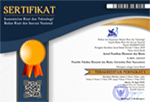PATH ANALYSIS OF MONETARY POLICY MECHANISMS: DOES ECONOMIC CAPACITY MEDIATE PRICES?
DOI:
https://doi.org/10.33633/jpeb.v5i2.3159Abstract
The single objective of Bank Indonesia is Rupiah's stability. Within the monetary policy framework, the monetary instruments affect the operational targets (money supply and interest rates). Those operational targets effect rupiah stability troughs its effect on economic capacity/GDP. Using 108 monthly data, that is analyzed by path analysis; this study discusses the effect of net foreign assets (NFA) and net domestic assets (NDA,) and interest rates on the prices (CPI) through their effects GDP. The results show that NFA and NDA have a significant positive effect on GDP, while interest rates are tended to be negative. However, neither the NFA nor the NDA has been proven to have a direct significant effect on CPI. The interest rate has been proven to have a direct significant effect on CPI. GDP was not proven to have a significant effect on the CPI and neither mediates the effects of operational targets on CPI.Keywords: Rupiah; Prices; CPI; Stability; MoneyReferences
Dimand, R. W. (2000). Irving Fisher and the Quantity Theory of Money: The Last Phase. Journal of the History of Economic Thought. https://doi.org/10.1080/10427710050122549
Elies Nur Fauziyah, W. (2016). Pengaruh Bi Rate Dan Jumlah Uang Yang Beredar Terhadap Tingkat Inflasi Di Indonesia. Jurnal Pendidikan Ekonomi (JUPE).
Hartomo, H. A. (2010). Pengaruh Jumlah Uang Beredar Dan Kurs Terhadap Tingkat Inflasi di Indonesia Sebelum Dan Setelah Krisis Global 2008. Media Ekonomi.
Herlina, D. (2018). Identifikasi Mekanisme Transmisi Kebijakan Moneter Saluran Uang dan Saluran Suku Bunga Di Indonesia. Jurnal Ekonomi-Qu. https://doi.org/10.35448/jequ.v8i2.4446
Indonesia, B. (n.d.). BI 7-day (Reverse) Repo Rate. Retrieved from https://www.bi.go.id/en/moneter/bi-7day-RR/penjelasan/Contents/Default.aspx
Jan Gottschalk, T. (2014). Monetary Transmission Mechanism: Workshop on Monetary and Exchange Rate Policy. Bangkok - Thailand: IMF.
Langi, T. M., Maisnambow, V., & Siwu, H. (2014). Analisis pengaruh suku bunga BI, jumlah uang beredar, dan tingkat kurs terhadap tingkat inflasi diiIndonesia. Jurnal Berkala Ilmiah Efisiensi.
Machmud, S., & Warjoko, B. A. (2013). Analisis Pengaruh Tingkat Inflasi, Nilai Tukar USD/Rupiah, Dan Tingkat Suku Bunga SBI Terhadap Indek Harga Saham Gabungan. Jurnal Ekonomi, Bisnis & Entrepreneurship.
Monetary and Financial Statistics Manual. (2000). In the Monetary and Financial Statistics Manual. https://doi.org/10.5089/9781589060296.049
Panjaitan, M., & Wardoyo, W. (2016). Faktor-Faktor yang Mempengaruhi Inflasi di Indonesia. Jurnal Ilmiah Ekonomi Bisnis.
Parlembang, H., Krisnaldy, & Ferdiansyah, F. (2017). Pengaruh Jumlah Uang Beredar, Produk Domestik Bruto, Kurs Dan Tingkat Bunga Terhadap Inflasi Di Indonesia Pendekatan Error Corection Model. Media Ekonomi. https://doi.org/10.25105/me.v19i3.771
Prasasti, K. B. (2017). Pengaruh Jumlah Uang Beredar Terhadap Harga Umum dan Suku Bunga. Serta Terhadap Investasi dan Pertumbuhan Ekonomi Di Indonesia Periode 1973-2012. Thesis. Universitas Airlangga.
Pratiwi, M. I., Kristianti, F. T., & Mahardika, D. P. K. (2016). Pengaruh Kepemilikan Manajerial, Kepemilikan Institusional, Dan Leverage Terhadap Nilai Perusahaan. E-Proceeding of Management.
Rifai, S. A., Susanti, H., & Setyaningrum, A. (2017). Analisis Pengaruh Kurs Rupiah, Laju In?asi, Jumlah Uang Beredar dan Pertumbuhan Ekspor terhadap Total Pembiayaan Perbankan Syariah dengan Dana Pihak Ketiga sebagai Variabel Moderating. MUQTASID Jurnal Ekonomi Dan Perbankan Syariah. https://doi.org/10.18326/muqtasid.v8i1.18-39
Rusiadi; Novalina, A., & Sembiring, R. (2017). Efektifitas Mekanisme Transmisi Kebijakan Moneter Melalui Jalur Suku Bunga terhadap Stabilitas Ekonomi Indonesia. JEpa.
Shiller, R. J. (2013). Irving Fisher, debt deflation, and crises. Journal of the History of Economic Thought. https://doi.org/10.1017/S1053837213000059
Sinaga, T. T., & Sudirman, I. W. (2018). Mekanisme Transmisi Kebijakan Moneter Dalam Perekonomian Indonesia. E-Jurnal Ekonomi Dan Bisnis Universitas Udayana. https://doi.org/10.24843/eeb.2018.v07.i08.p04
Susilowati, M. W. K., & Wahyuningdyah, R. Y. (2018). Efektivitas BI7DRR dalam Kerangka Mekanisme Transmisi Kebijakan Moneter untuk Pengendalian Inflasi. PRAXIS, 1(1), 78–92. https://doi.org/10.24167/PRAXIS.V1I1.1627
Sutawijaya, A. (2012). Pengaruh Faktor-Faktor Ekonomi Terhadap Inflasi di Indonesia. Jurnal Organisasi Dan Manajemen.
Wulandari, N., & Rahmadeni. (2017). Analisis Faktor-Faktor yang Mempengaruhi Inflasi pada Kota Metropolitan di Indonesia dengan Menggunakan Analisis Data Panel. Jurnal Sains Matematika Dan Statistika. https://doi.org/http://dx.doi.org/10.24014/jsms.v3i2.4475
Downloads
Published
How to Cite
Issue
Section
License
The copyright of the received article shall be assigned to the journal as the publisher of the journal. The intended copyright includes the right to publish the article in various forms (including reprints). The journal maintains the publishing rights to the published articles.
This work is licensed under a Creative Commons Attribution 4.0 International License.


.png)









